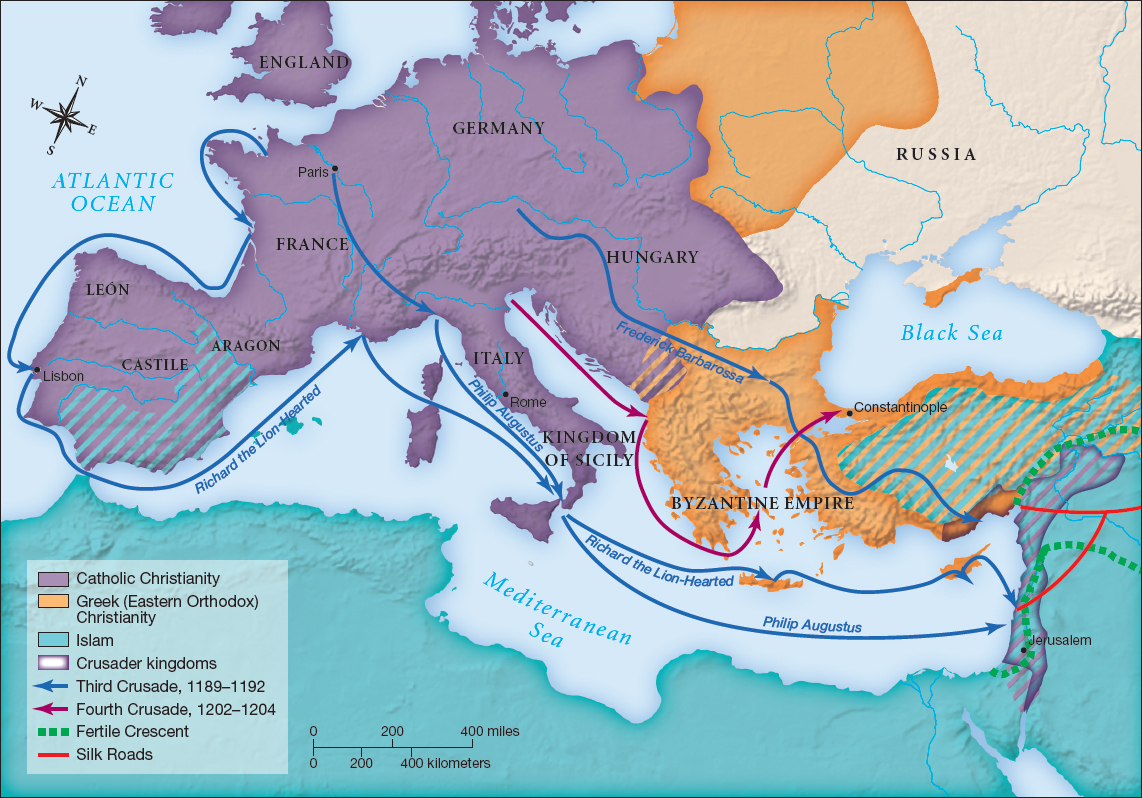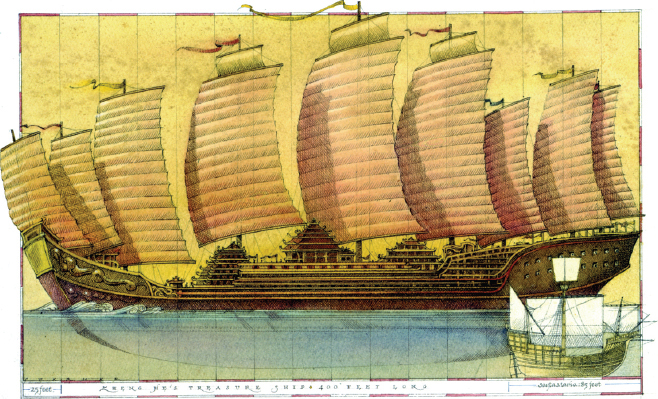Exploring American Histories: Printed Page 9
Exploring American Histories, Value Edition: Printed Page 7
The Mediterranean World
For several centuries before 1500, Islam proved one of the most dynamic cultural, political, and military forces in the world. By the ninth century, Islamic (also known as Muslim) regimes controlled most of southwest Asia and North Africa and conquered parts of the Iberian peninsula. The Muslims’ greatest competitors were the Ottoman Turks, not European Catholics (Map 1.2). Still, in the eleventh and twelfth centuries, Catholic leaders launched several military and religious campaigns to reclaim the Holy Land for the church. Later known as the Crusades, these campaigns largely failed in establishing Christian settlements in the East and exacerbated conflicts with Greek Orthodox and Jewish communities. But they enhanced the roles of Italian merchants, who profited from both outfitting Crusaders and opening new trade routes to the East. Moreover, these campaigns inspired explorers and adventurers throughout Europe.

Medieval European elites were first introduced to goods and ideas from the East by merchant adventurers such as Marco Polo. He traveled to Cathay (his name for China) during the 1270s and published his Travels in 1292. Describing his adventures along the Silk Road, Polo introduced Europeans to “burning rocks” (coal), spices that preserved meat, and other wonders of the Far East.
Europeans also learned of successful civilizations in the Middle East, where inhabitants had managed to survive droughts and other ecological crises, largely because of their productive economic systems. In the Mediterranean world, this productivity depended on technological advances in irrigation and navigation and on adequate labor in the form of slavery. Earlier European societies as well as the Aztecs, Incas, and Maya had put conquered peoples to work as slaves, but none compared to the vast network of slave-trading centers that fueled agricultural development in the Middle East. And it was the productivity of agriculture—developed centuries earlier than in Europe or America—that allowed societies along the southern Mediterranean, in northern Africa, and in southwest Asia to excel in astronomy, mathematics, architecture, and the arts.
Medieval European states proved far less adept at staving off human and environmental disasters than their counterparts to the south. Besieged by drought and disease as well as wars and peasant rebellions, rulers across the continent expended most of their resources on trying to sustain their population and protect their borders. Even launching trade with Asia led to disaster: In the 1340s, the bubonic plague was carried from Central Asia to Middle Eastern and European seaports by rats stowed away on ships. Sailors who contracted the disease at sea also spread the infection far and wide. From the 1340s to the early fifteenth century, the plague—later called the Black Death—periodically ravaged European cities and towns. During the initial outbreak between 1346 and 1350, about 36 million people—half of Europe’s population—perished. At the same time, France and England engaged in a century-long war that added to the death and destruction.
By the early fifteenth century, the plague had retreated from much of Europe, and the climate had improved. Only then were European peoples able to benefit significantly from the riches of the East. Smaller populations led to an improved standard of living. Then rising birthrates and increased productivity, beginning in Italian city-states, fueled a resurgence of trade with other parts of the world. The profits from agriculture and commerce allowed the wealthy and powerful to begin investing in painting, sculpture, music, and literature and to pay jewelers, potters, and other craftsmen for their wares. Indeed, a cultural Renaissance (from the French word for “rebirth”) flourished in the Italian city-states and then spread to France, Spain, the Low Countries, and central Europe.
The cultural rebirth went hand in hand with political unification as more powerful rulers extended their control over smaller city-states and principalities. In 1469, for example, the marriage of Isabella of Castile and Ferdinand II of Aragon led to the unification of Spain. By 1492 their combined forces expelled the last Muslim conquerors from the Iberian peninsula. Promoting Catholicism to create a more unified national identity, Isabella and Ferdinand also launched a brutal Inquisition against supposed heretics and executed or expelled Jews and Muslims. This reconquest of the Iberian peninsula fueled the revival of trade with North Africa, India, and other Asian lands.

Yet Italy controlled the most important routes through the Mediterranean, so leaders in Spain and Portugal sought alternate paths to riches. Their efforts were aided by explorers, missionaries, and merchants who traveled to Morocco, Turkey, India, and other distant lands. They brought back trade goods and knowledge of astronomy, shipbuilding, mapmaking, and navigation that allowed Iberians to venture farther south along the Atlantic coast of Africa and, eventually, west into the uncharted Atlantic Ocean.